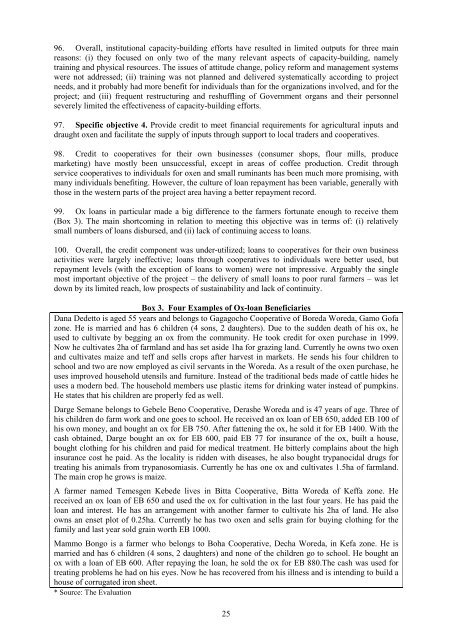Ethiopia SOCODEP CE - main report - IFAD
Ethiopia SOCODEP CE - main report - IFAD
Ethiopia SOCODEP CE - main report - IFAD
You also want an ePaper? Increase the reach of your titles
YUMPU automatically turns print PDFs into web optimized ePapers that Google loves.
96. Overall, institutional capacity-building efforts have resulted in limited outputs for three <strong>main</strong><br />
reasons: (i) they focused on only two of the many relevant aspects of capacity-building, namely<br />
training and physical resources. The issues of attitude change, policy reform and management systems<br />
were not addressed; (ii) training was not planned and delivered systematically according to project<br />
needs, and it probably had more benefit for individuals than for the organizations involved, and for the<br />
project; and (iii) frequent restructuring and reshuffling of Government organs and their personnel<br />
severely limited the effectiveness of capacity-building efforts.<br />
97. Specific objective 4. Provide credit to meet financial requirements for agricultural inputs and<br />
draught oxen and facilitate the supply of inputs through support to local traders and cooperatives.<br />
98. Credit to cooperatives for their own businesses (consumer shops, flour mills, produce<br />
marketing) have mostly been unsuccessful, except in areas of coffee production. Credit through<br />
service cooperatives to individuals for oxen and small ruminants has been much more promising, with<br />
many individuals benefiting. However, the culture of loan repayment has been variable, generally with<br />
those in the western parts of the project area having a better repayment record.<br />
99. Ox loans in particular made a big difference to the farmers fortunate enough to receive them<br />
(Box 3). The <strong>main</strong> shortcoming in relation to meeting this objective was in terms of: (i) relatively<br />
small numbers of loans disbursed, and (ii) lack of continuing access to loans.<br />
100. Overall, the credit component was under-utilized; loans to cooperatives for their own business<br />
activities were largely ineffective; loans through cooperatives to individuals were better used, but<br />
repayment levels (with the exception of loans to women) were not impressive. Arguably the single<br />
most important objective of the project – the delivery of small loans to poor rural farmers – was let<br />
down by its limited reach, low prospects of sustainability and lack of continuity.<br />
Box 3. Four Examples of Ox-loan Beneficiaries<br />
Dana Dedetto is aged 55 years and belongs to Gagagocho Cooperative of Boreda Woreda, Gamo Gofa<br />
zone. He is married and has 6 children (4 sons, 2 daughters). Due to the sudden death of his ox, he<br />
used to cultivate by begging an ox from the community. He took credit for oxen purchase in 1999.<br />
Now he cultivates 2ha of farmland and has set aside 1ha for grazing land. Currently he owns two oxen<br />
and cultivates maize and teff and sells crops after harvest in markets. He sends his four children to<br />
school and two are now employed as civil servants in the Woreda. As a result of the oxen purchase, he<br />
uses improved household utensils and furniture. Instead of the traditional beds made of cattle hides he<br />
uses a modern bed. The household members use plastic items for drinking water instead of pumpkins.<br />
He states that his children are properly fed as well.<br />
Darge Semane belongs to Gebele Beno Cooperative, Derashe Woreda and is 47 years of age. Three of<br />
his children do farm work and one goes to school. He received an ox loan of EB 650, added EB 100 of<br />
his own money, and bought an ox for EB 750. After fattening the ox, he sold it for EB 1400. With the<br />
cash obtained, Darge bought an ox for EB 600, paid EB 77 for insurance of the ox, built a house,<br />
bought clothing for his children and paid for medical treatment. He bitterly complains about the high<br />
insurance cost he paid. As the locality is ridden with diseases, he also bought trypanocidal drugs for<br />
treating his animals from trypanosomiasis. Currently he has one ox and cultivates 1.5ha of farmland.<br />
The <strong>main</strong> crop he grows is maize.<br />
A farmer named Temesgen Kebede lives in Bitta Cooperative, Bitta Woreda of Keffa zone. He<br />
received an ox loan of EB 650 and used the ox for cultivation in the last four years. He has paid the<br />
loan and interest. He has an arrangement with another farmer to cultivate his 2ha of land. He also<br />
owns an enset plot of 0.25ha. Currently he has two oxen and sells grain for buying clothing for the<br />
family and last year sold grain worth EB 1000.<br />
Mammo Bongo is a farmer who belongs to Boha Cooperative, Decha Woreda, in Kefa zone. He is<br />
married and has 6 children (4 sons, 2 daughters) and none of the children go to school. He bought an<br />
ox with a loan of EB 600. After repaying the loan, he sold the ox for EB 880.The cash was used for<br />
treating problems he had on his eyes. Now he has recovered from his illness and is intending to build a<br />
house of corrugated iron sheet.<br />
* Source: The Evaluation<br />
25

















